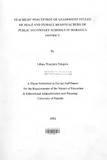Tariff Reduction / Removal Effects and Effective and Defective of the Implementation Common Market for Eastern and Southern Africa (Comes a) on Keny a's Sugar Industry
Abstract
Sugar tariff reduction / removal by reducing sugar prices within Kenya, discourages production in this import competing industry while at the same time boosts demand for imported sugar, which finally lead to unprecedented increase in imports. Whereas, the Kenyan consumers would benefit from cheaper imported sugar the domestic producers and the government would lose market and revenue respectively. In a scenario where sugar imports are so huge domestic production of sugar would grind to a halt altogether. thus creating a negative impact on the industry. Unilateral tariff liberalization, COMESA tariff liberalization and Export Promotion Programme Office (EPPO) scheme have been under implementation since 1992. This has resulted in a dramatic increase of sugar imports starting from 1992. This paper analyses the determinant of sugar imports into Kenya, in an attempt to explain the huge influx of sugar into the country, despite the availability of locally produced sugar. Specifically, it analyses the impact of COMESA tariff reduction / removal on sugar imports. Using a sample of 44 countries. 32 non - COMESA and 12 COMESA countries over a period 1981 to 2000. the empirical results show that low domestic sugar production levels, large sugar exporters' population size and increase in Kenya's population size, unilateral tariff rates, and COMESA regional integration significantly determine the increase in sugar imports in Kenya. Whereas, low sugar output, large population sizes of both sugar exporters and Kenya, and progress in the integration process are responsible for the increase in sugar imports, unilateral tariff liberalization is responsible for the decline in sugar inflow, because of trade diversion. The model actually explains the increase in sugar inflows into Kenya as being mainly due to the short fall in domestic sugar production. Despite. COMESA tariff regime promoting the inflow of sugar imports its influence in determining the high influx of sugar into Kenya is not significant. The study therefore concludes that Kenya should restructure the sugar production activities to be able to produce adequate sugar for consumption and export purpose. Furthermore, technology that can produce the refined industrial sugar should be acquired to reduce import of this commodity from outside Kenya.
Citation
Research Paper submitted to the Department of Economics,University of Nairobi, in partial fulfillment of the requirements for the award of the degree of Master of Arts in EconomicsPublisher
Department of Arts-Economics

